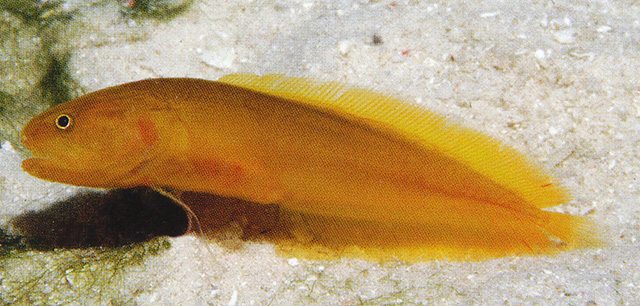| Bythitidae (Viviparous brotulas), subfamily: Brosmophycinae |
| 10.3 cm SL (male/unsexed); 10 cm SL (female) |
|
reef-associated; depth range 5 - 25 m |
| Western Central Pacific: Great Barrier Reef north of 16°S and in Papua New Guinea south of 5°S; westwards in Maluku, Indonesia; along the Louisiade Archipelago to the Solomon Islands including Santa Cruz Islands and Vanuatu. |
|
Dorsal soft rays (total): 74-85; Anal soft rays: 60-69; Vertebrae: 43-45. The species is characterized by the following: vertebrae 11+32-34=43-45, dorsal fin rays 74-85 (mostly >77), anal fin rays 60-69, D/V 6 (rarely 7); large eyes (2.1-3.4% SL); outer pseudoclasper with broad hook-shaped extension, with rounded tip, slightly bent outwards; inner pseudoclasper short, joined to outer pseudoclasper anteriorly, supporter with anteriorly oriented small hook, and with a wide thin flap at posterior-distal margin; scale patch on cheek with 7-9 scale rows on upper cheek, many scales on operculum above opercular spin (7-16 scales in 2-4 rows), in very large specimens additional scale patch below opercular spine (4-12); head profile is moderately slender; otolith length sulcus length 1.9-2.0, sulcus slightly inclined (Ref. 57884).
Description: Characterized by depth of body at anal fin origin 15.1-20.8 (mean=18.4) % SL (Ref. 90102). |
| Rare species, found on coral-sand bottom (Ref. 34024). Benthic (Ref. 75154). Cryptic and solitary (Ref 90102). |
|
(Ref. 96402)
|
| harmless |
|
Source and more info: www.fishbase.org. For personal, classroom, and other internal use only. Not for publication.
Page created by Jen, 05.08.02,
php script by kbanasihan 06/09/2010 ,
last modified by
dsantos, 20/08/10

